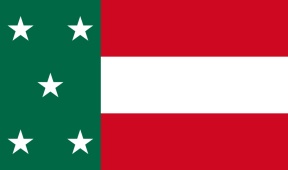By Daniel Nardini
 In a show of honoring the Yucatan peninsula’s past, Yucatan Governor Mauricio Vila and other state officials raised the flag of the former Republic of the Yucatan. The ceremony marked the coming to terms with the Yucatan’s turbulent historic past, and that the flag of the Republic of the Yucatan is no longer seen as a symbol of revolt against Mexico but as a cultural heritage of the Yucatan peninsula. A recent change in the Mexican Constitution has allowed for state and local officials to be able to display flags, coats or arms and symbols of their locale along with the national flag of Mexico. Hence, the flag of the former Republic of the Yucatan can now be legally flown for the first time since the existence of the Second Republic of the Yucatan. The flag, containing five white stars in a green square background and two red stripes with a white stripe in the middle, had first flown over the Yucatan in 1823.
In a show of honoring the Yucatan peninsula’s past, Yucatan Governor Mauricio Vila and other state officials raised the flag of the former Republic of the Yucatan. The ceremony marked the coming to terms with the Yucatan’s turbulent historic past, and that the flag of the Republic of the Yucatan is no longer seen as a symbol of revolt against Mexico but as a cultural heritage of the Yucatan peninsula. A recent change in the Mexican Constitution has allowed for state and local officials to be able to display flags, coats or arms and symbols of their locale along with the national flag of Mexico. Hence, the flag of the former Republic of the Yucatan can now be legally flown for the first time since the existence of the Second Republic of the Yucatan. The flag, containing five white stars in a green square background and two red stripes with a white stripe in the middle, had first flown over the Yucatan in 1823.
In 1821, when Mexico gained its independence from Spain, the Yucatan peninsula was in fact de facto independent from Spain before the rest of Mexico had gained its independence. The central government in Mexico City had never really held control of the Yucatan. Yet like Mexico in Spanish colonial times, the Yucatan was a microcosm of Spanish colonial society. At the top were the peninsulares; those born in Spain but had moved to New Spain to administer the colony. Then there were the criollos; those born of Spanish blood but who were born in New Spain, and below them were the mestizos or those of mixed Spain and native Indian blood. The largest number of people in the Yucatan were the Mayans, who had lived there for thousands of years. Independence had not changed the social or class make-up of the Yucatan. In 1823, when Mexico was an empire, the peninsulares and criollos wanted to have nothing to do with the Mexican state so they declared their independence in what became known as the First Republic of the Yucatan. But when Mexico had change from an empire to a republic, the ruling class of Yucatan rejoined Mexico just seven months after they had declared their own republic.
In 1847, the ruling class of the Yucatan had again separated from the rest of Mexico when Mexico was involved in a war with the United States known as the U.S.-Mexico War (1846-1848). The Second Republic of the Yucatan had come into existence. The former peninsulares, criollos and mestizos, who became known as the Hispanic population of the Yucatan (yucatecos), wanted to have nothing to do with the dictatorship of Antonio Lopez de Santa Anna in Mexico City. With Mexico being too pre-occupied with its war against the United States, the Second Republic of the Yucatan might have survived to this day. However, the Mayans, who had endured centuries of being dispossessed of their lands, revolted and they killed as many of the Hispanic population as they could. Fighting a losing war against the Mayan revolt, becoming known as the Caste War, drove the yucatecos to rejoin the Republic of Mexico in 1848 so they could receive protection from the Mayan rebels. The Mayans would continue their fight against Mexico into the early 20th Century, but the Second Republic of the Yucatan had come to an end. Today, the Republic of the Yucatan flag, like the old Confederate States of America Virginia battle flag, has become little more than a historic curiosity of a time long gone by. The original meaning of what it was has long since been lost to time, and now is more about its historic heritage than anything else.
 Villanueva-Backed Law to Protect Access to Illinois Courthouses December 11, 2025
Villanueva-Backed Law to Protect Access to Illinois Courthouses December 11, 2025









The Flag of the Republic of Yucatan Rises Again
By Daniel Nardini
In 1821, when Mexico gained its independence from Spain, the Yucatan peninsula was in fact de facto independent from Spain before the rest of Mexico had gained its independence. The central government in Mexico City had never really held control of the Yucatan. Yet like Mexico in Spanish colonial times, the Yucatan was a microcosm of Spanish colonial society. At the top were the peninsulares; those born in Spain but had moved to New Spain to administer the colony. Then there were the criollos; those born of Spanish blood but who were born in New Spain, and below them were the mestizos or those of mixed Spain and native Indian blood. The largest number of people in the Yucatan were the Mayans, who had lived there for thousands of years. Independence had not changed the social or class make-up of the Yucatan. In 1823, when Mexico was an empire, the peninsulares and criollos wanted to have nothing to do with the Mexican state so they declared their independence in what became known as the First Republic of the Yucatan. But when Mexico had change from an empire to a republic, the ruling class of Yucatan rejoined Mexico just seven months after they had declared their own republic.
In 1847, the ruling class of the Yucatan had again separated from the rest of Mexico when Mexico was involved in a war with the United States known as the U.S.-Mexico War (1846-1848). The Second Republic of the Yucatan had come into existence. The former peninsulares, criollos and mestizos, who became known as the Hispanic population of the Yucatan (yucatecos), wanted to have nothing to do with the dictatorship of Antonio Lopez de Santa Anna in Mexico City. With Mexico being too pre-occupied with its war against the United States, the Second Republic of the Yucatan might have survived to this day. However, the Mayans, who had endured centuries of being dispossessed of their lands, revolted and they killed as many of the Hispanic population as they could. Fighting a losing war against the Mayan revolt, becoming known as the Caste War, drove the yucatecos to rejoin the Republic of Mexico in 1848 so they could receive protection from the Mayan rebels. The Mayans would continue their fight against Mexico into the early 20th Century, but the Second Republic of the Yucatan had come to an end. Today, the Republic of the Yucatan flag, like the old Confederate States of America Virginia battle flag, has become little more than a historic curiosity of a time long gone by. The original meaning of what it was has long since been lost to time, and now is more about its historic heritage than anything else.